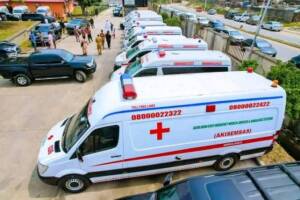Signature projects of Governor Umo Eno in health sector, legacy series

By Emmanuel Nicholas
Governor Umo Eno, has formally proclaimed a state of emergency in the health sector and moved swiftly to translate that proclamation from mere rhetoric into tangible action, mobilizing resources and instituting measures designed to produce immediate and sustained improvements in public health delivery.
Rather than cataloguing the administrative details of the emergency programme itself, this piece will concentrate on the enduring infrastructure and reform initiatives that constitute his legacy in the health sector—those signature projects within the Arise Agenda that will define his tenure long after short-term interventions have elapsed.
Central to any assessment of legacy are the large-scale investments and systemic reforms likely to outlast a single administration: the construction and modernization of Specialties abd General hospitals and primary-care centres; the training, recruitment, and retention strategies for healthcare professionals; the strengthening of supply chains for essential medicines and equipment; the expansion of community-based preventive services; and the digitisation of health records and administrative processes to improve efficiency and accountability.
Governor Umo Eno has launched an unprecedented recruitment drive for healthcare personnel, expanding staff numbers on a scale no previous administration has attempted. He has commenced the employment of three thousand medical workers, accompanied by enhanced welfare provisions and increased living wages.
Referal -Referal – Speciities Hospital
The Ibom International Hospital (IIH) is envisioned as a JCI‑accredited, quaternary‑level referral centre anchored in the Ibom Medical City along the state’s Medical Corridor.
As a flagship of the ARISE agenda under Governor Umo Eno and implemented by the Akwa Ibom Ministry of Health, IIH sits within a larger cluster that will include multispecialty hospitals, academic institutions, pharmaceutical parks and residential support for health professionals.
The hospital’s clear mandate is to deliver world‑class, multidisciplinary care and to serve as a regional referral hub.
IIH is designed to provide the highest level of clinical complexity across a vast range of specialties, from advanced neurosurgery, transplant medicine and cardiothoracic surgery to interventional cardiology, oncology, reproductive medicine/IVF and paediatric critical care.
The clinical footprint is strengthened by cutting‑edge technology: TrueBeam linear accelerator radiotherapy, cyclotron, PET‑CT, intra‑operative MRI/CT, 3T MRI, O‑Arm, a Da Vinci robotic surgery suite and ten modular super‑sterile operating theatres (including dedicated transplant ORs).
This combination of expertise and equipment positions IIH to manage rare, high‑acuity cases that typically require travel abroad.
The hospital’s physical infrastructure and patient experience are tailored for both complex care and high expectations.
The 9‑storey facility (37,000 sqm) features a grand three‑story atrium, wellness gardens including a rooftop Lifestyle Medicine centre, VIP and VVIP suites, sauna and spa facilities, NICU/PICU, specialized burn unit, helipad and dedicated VVIP underground parking. IIH is a smart, secure building with advanced HVAC (HEPA and laminar zones), full medical gas systems and a 2‑MW solar farm, attributes that support infection control, reliability and patient comfort.
Located inside a planned Medical City, the hospital can offer bundled services (treatment, accommodation, rehabilitation, and pharmaceutical access) attractive to international patients.
IIH also brings strong institutional capacity for research, training and professional collaboration. Planned laboratory genetics/genomics research, links to academic institutions, and endorsements from a wide range of Nigerian professional bodies (medical, nursing, pharmacy, allied health) signal a robust workforce and governance support.
The projected economic impact of thousands of construction and permanent jobs and local vendor engagement further underlines sustainability and community integration, important factors for long‑term medical tourism credibility and partnerships with insurers, foreign hospitals and medical travel facilitators.
Medical tourism potential: IIH is well placed to become a major destination for regional and diaspora patients seeking high‑complexity care that today often requires travel to Europe or Asia.
Key selling points include: comprehensive quaternary services (transplant, oncology, cardiothoracic and neuro‑surgery, IVF), advanced diagnostics and therapy (cyclotron, PET‑CT, intra‑op MRI), robotic surgery and super‑sterile ORs; one‑stop continuity of care within a Medical City; luxury recovery and wellness amenities; rapid access via helipad and VIP logistics; sustainability and uninterrupted power backed by onsite solar; and the pursuit of JCI accreditation to build international.
Secondary health care
Governor Umo Eno has made strengthening secondary healthcare a priority across the state, not only by revamping and re‑equipping existing general hospitals but also by creating additional modern facilities to expand access to quality care.
General Hospital -Ukanafun
A flagship example of this commitment is in Ukanafun Local Government Area, where a project that began seventeen years ago as an abandoned cottage hospital has been completed, expanded and upgraded into a fully functioning general hospital.
The facility is outfitted with a wide range of modern diagnostic, therapeutic and support equipment to meet the health needs of the community.
Diagnostic and monitoring capabilities include a digital X‑ray unit with viewing/PACS capability, ultrasound scanners with obstetric probes, ECG machines with treadmill/diagnostic capability, multiparameter patient monitors for wards and theatres, pulse oximeters and portable vital‑sign monitors, and both manual and automated external defibrillators.
The laboratory and blood services are equipped for routine and emergency testing: a clinical chemistry analyzer for basic biochemistry, a hematology analyzer for CBCs, urine and stool analyzers with microscopy stations, centrifuges, incubators and microscopes, a blood bank refrigerator/freezer and blood storage supplies, rapid diagnostic test kits (malaria, HIV, pregnancy, etc.), and a basic microbiology setup for culture and sensitivity where feasible.
Operating theatres and anaesthesia services have been fully fitted with surgical instrument sets, anaesthesia machines and ventilators suited for theatre use, surgical lights and operating tables, electrosurgical units, suction systems and oxygen delivery interfaces, as well as sterilization equipment including autoclaves, instrument washers and sterile storage.
Emergency, critical care and intensive care provisions include emergency/trauma resuscitation trolleys (crash carts), mechanical ventilators for ICU or high‑dependency care, infusion and syringe pumps, portable X‑ray and ultrasound for emergency use, and a central oxygen supply with backup cylinders or a PSA oxygen plant.
Maternity, neonatal and paediatric services have been strengthened with delivery beds and labour ward facilities, neonatal resuscitation equipment (bag‑valve masks and suction), infant incubators and radiant warmers, CTG/fetal monitoring where available, and paediatric monitors plus equipment for measuring weight and height.
Supporting this clinical capacity are essential infrastructure and services: reliable electricity through grid, generator and UPS systems, dependable water supply, medical oxygen generation or bulk oxygen with piped distribution where possible, sterile supply departments, laundry and a pharmacy with cold‑chain refrigeration, and comprehensive waste management including sharps containers, incineration or pits and color‑coded waste segregation.
These installations represent only a selection of the many facilities and systems now in place at the upgraded Ukanafun General Hospital, and they reflect Governor Umo Eno’s broader drive to raise the standard of secondary healthcare across the state.
The General Hospital -Nsit Ubium
General Hospital, Nsit Ubium, represents a major new investment in the health infrastructure of Nsit Ubium Local Government Area. Conceived as a comprehensive, modern facility, the hospital is intended to deliver accessible, high-quality medical care to residents of the area and to serve as a focal point for community health initiatives and preventive services.
Governor Umo Eno has commenced construction of this brand‑new General Hospital in Nsit Ubium Local Government Area, a project designed to expand the reach of public healthcare and to strengthen local capacity for diagnosis, treatment and emergency response. The development is being undertaken with the explicit aim of reducing avoidable referrals, improving maternal and child health outcomes, and enhancing the overall resilience of the local health system.
The proposed facility will encompass a broad spectrum of clinical and support departments, including an Accident & Emergency (A&E) Department; general Outpatient Clinics; inpatient Wards; Surgical Theatres and a peri‑operative suite; a Maternity and Obstetrics & Gynaecology Unit; a Paediatric Unit; an Intensive Care Unit (ICU) and High‑Dependency Unit; Diagnostic Imaging services (e.g., X‑ray and ultrasound, with provision for advanced imaging as resources allow); a fully equipped Clinical Laboratory; an in‑house Pharmacy; Physiotherapy and Rehabilitation services; Dental and Mental Health/Behavioural Health services; and essential administrative, medical records and sterile services. Ancillary departments such as biomedical engineering, medical waste management, kitchen and laundry services, and a mortuary will also be provided to ensure seamless hospital operations.
Once completed, the General Hospital, Nsit Ubium, is expected to relieve pressure on tertiary centres, shorten travel times for patients, create employment and professional development opportunities for health workers, and catalyse improved public‑health outcomes across the Local Government Area. The project embodies a commitment to delivering integrated, patient‑centred care in adherence to recognised clinical standards and to the sustained health and well-being of the community.
The secondary healthcare
Governor Umo Eno has made strengthening secondary healthcare a priority across the state, not only by revamping and re‑equipping existing general hospitals but also by creating additional modern facilities to expand access to quality care.
General Hospital -Ukanafun
A flagship example of this commitment is in Ukanafun Local Government Area, where a project that began seventeen years ago as an abandoned cottage hospital has been completed, expanded and upgraded into a fully functioning general hospital. The facility is outfitted with a wide range of modern diagnostic, therapeutic and support equipment to meet the health needs of the community.
Diagnostic and monitoring capabilities include a digital X‑ray unit with viewing/PACS capability, ultrasound scanners with obstetric probes, ECG machines with treadmill/diagnostic capability, multiparameter patient monitors for wards and theatres, pulse oximeters and portable vital‑sign monitors, and both manual and automated external defibrillators.
The laboratory and blood services are equipped for routine and emergency testing: a clinical chemistry analyzer for basic biochemistry, a hematology analyzer for CBCs, urine and stool analyzers with microscopy stations, centrifuges, incubators and microscopes, a blood bank refrigerator/freezer and blood storage supplies, rapid diagnostic test kits (malaria, HIV, pregnancy, etc.), and a basic microbiology setup for culture and sensitivity where feasible.
Operating theatres and anaesthesia services have been fully fitted with surgical instrument sets, anaesthesia machines and ventilators suited for theatre use, surgical lights and operating tables, electrosurgical units, suction systems and oxygen delivery interfaces, as well as sterilization equipment including autoclaves, instrument washers and sterile storage.
Emergency, critical care and intensive care provisions include emergency/trauma resuscitation trolleys (crash carts), mechanical ventilators for ICU or high‑dependency care, infusion and syringe pumps, portable X‑ray and ultrasound for emergency use, and a central oxygen supply with backup cylinders or a PSA oxygen plant.
Maternity, neonatal and paediatric services have been strengthened with delivery beds and labour ward facilities, neonatal resuscitation equipment (bag‑valve masks and suction), infant incubators and radiant warmers, CTG/fetal monitoring where available, and paediatric monitors plus equipment for measuring weight and height.
Supporting this clinical capacity are essential infrastructure and services: reliable electricity through grid, generator and UPS systems, dependable water supply, medical oxygen generation or bulk oxygen with piped distribution where possible, sterile supply departments, laundry and a pharmacy with cold‑chain refrigeration, and comprehensive waste management including sharps containers, incineration or pits and color‑coded waste segregation.
These installations represent only a selection of the many facilities and systems now in place at the upgraded Ukanafun General Hospital, and they reflect Governor Umo Eno’s broader drive to raise the standard of secondary healthcare across the state.
The General Hospital -Nsit Ubium
General Hospital, Nsit Ubium, represents a major new investment in the health infrastructure of Nsit Ubium Local Government Area. Conceived as a comprehensive, modern facility, the hospital is intended to deliver accessible, high-quality medical care to residents of the area and to serve as a focal point for community health initiatives and preventive services.
Governor Umo Eno has commenced construction of this brand‑new General Hospital in Nsit Ubium Local Government Area, a project designed to expand the reach of public healthcare and to strengthen local capacity for diagnosis, treatment and emergency response. The development is being undertaken with the explicit aim of reducing avoidable referrals, improving maternal and child health outcomes, and enhancing the overall resilience of the local health system.
The proposed facility will encompass a broad spectrum of clinical and support departments, including an Accident & Emergency (A&E) Department; general Outpatient Clinics; inpatient Wards; Surgical Theatres and a peri‑operative suite; a Maternity and Obstetrics & Gynaecology Unit; a Paediatric Unit; an Intensive Care Unit (ICU) and High‑Dependency Unit; Diagnostic Imaging services (e.g., X‑ray and ultrasound, with provision for advanced imaging as resources allow); a fully equipped Clinical Laboratory; an in‑house Pharmacy; Physiotherapy and Rehabilitation services; Dental and Mental Health/Behavioural Health services; and essential administrative, medical records and sterile services. Ancillary departments such as biomedical engineering, medical waste management, kitchen and laundry services, and a mortuary will also be provided to ensure seamless hospital operations.
Once completed, the General Hospital, Nsit Ubium, is expected to relieve pressure on tertiary centres, shorten travel times for patients, create employment and professional development opportunities for health workers, and catalyse improved public‑health outcomes across the Local Government Area. The project embodies a commitment to delivering integrated, patient‑centred care in adherence to recognised clinical standards and to the sustained health and well-being of the community.
Primary healthcare
Upon assuming office, the Governor embarked on an ambitious programme to rebuild and equip at least one primary health centre in each Local Government Area with modern facilities.
This initiative aims to eliminate the chronic shortage of health services in rural communities and to prevent the unnecessary escalation of cases from primary to secondary care. Many primary health centres were previously understaffed, ill-equipped, and in a deplorable state, suffering environmental damage and, in some instances, looting and vandalism. Governor Umo Eno’s blueprint addresses these challenges by upgrading infrastructure, retraining and expanding the health workforce, strengthening facility security, and providing staff housing to reduce burdensome commuting for health personnel.
Among the modern health centres completed are Primary Health Centre, Oboyo Ikot Ita, Nsit Ibom local government area, Model Primary Health Centre, Efa, Etinan Local government area, Modern Health Centre- Nsit Atai, Modern Health Centre – Ibesikpo
Modern Health Centre Mbiaya Uruan, Modern Health Centre, Oron, Modern Health center Obot Akara, Modern Health center, Oruk Anam, Modern Health center, Ikot Abasi, Modern Health center, Wellington Bassey Way, Uyo, among others.
The Home for the elderly
The Arise Elderly Homes, a flagship undertaking situated within the medical corridor, constitute a comprehensive, purpose-built complex designed to deliver an integrated continuum of care and lifestyle services for older adults.
This multifaceted facility brings together a fully equipped clinic, a gymnasium, a recreational game village, comfortable hostel accommodations, a restaurant, a convivial social lounge, and a swimming pool, each element deliberately arranged to serve clinical, rehabilitative, recreational and hospitable functions in concert.
Engineered with accessibility, safety, and dignified living standards at its core, the development seeks to harmonize medical oversight with opportunities for physical activity, leisure and socialization, thereby enabling visitors to maintain autonomy while receiving responsive support.
Beyond its tangible amenities, Arise Elderly Homes embodies a holistic philosophy of ageing well, emphasizing physical health, cognitive stimulation, emotional wellbeing and social connectedness.
Programmatic offerings ranging from therapeutic exercise and preventative health screenings to organized recreational pursuits, communal dining and resident-centred social programming are intended to foster resilience, reduce isolation and enhance quality of life. In partnership with adjacent medical institutions and community stakeholders, the facility aspires not only to provide immediate care and respite for families, but also to serve as a model for integrated eldercare that advances best practices in geriatric medicine, rehabilitation and compassionate living environments.
Ambulance -24 -hour emergency center
Governor Umo Eno has established a state-of-the-art emergency care center equipped with thirty-one ambulance–clinic vehicles designed to provide immediate prehospital intervention and stabilization before referral.
The facility comprises a fully outfitted clinic furnished with comprehensive emergency medical equipment capable of managing a broad spectrum of acute presentations, and it maintains a continuously staffed, toll‑free 24‑hour call and dispatch centre to coordinate rapid response.
The ambulance fleet and clinical team deliver integrated prehospital care, including basic life support (BLS) and advanced life support (ALS) interventions such as airway management (endotracheal intubation and supraglottic devices), cardiopulmonary resuscitation (CPR), automated external defibrillation (AEDs and manual defibrillators), advanced cardiac life support (ACLS), hemorrhage control, oxygen therapy, intravenous access and fluid resuscitation, and rapid sequence induction where indicated.
The centre operates structured triage protocols, trauma and medical emergency algorithms, point‑of‑care diagnostics (portable glucometry, pulse oximetry, and portable ECG/telemetry), and is staffed by trained emergency medical technicians, paramedics, and emergency physicians to ensure timely stabilization and appropriate referral to higher‑level care.
The 24‑hour toll‑free call centre functions as a centralised emergency medical dispatch (EMD) hub, providing telephone triage, prearrival instructions, and coordination of ambulance deployment, interfacility transfers, and telemedicine consults. Integrated with electronic patient care records and regional hospital networks, the system supports continuity of care through real‑time telemetry transmission, bedside handover protocols, and expedited transfer pathways to specialised services such as cardiology, neurosurgery, and intensive care units when advanced definitive management is required.
My foot note
Governor Umo Eno’s health-sector emergency has been translated into a coherent set of long‑term investments and system reforms that together constitute a distinctive legacy.
From the quaternary‑level Ibom International Hospital and the networked Medical City to upgraded general hospitals in Ukanafun and Nsit Ubium, revitalised primary health centres across the state, the Arise Elderly Homes and a modern 24‑hour emergency and ambulance service, the programme intentionally spans prevention, acute care and specialist referral.
These projects pair high‑end clinical capability and technology with pragmatic upgrades to secondary and primary care, creating an integrated platform designed to meet routine community needs and manage high‑acuity cases that previously necessitated travel abroad.
The likely dividends are many: shorter referral pathways, stronger emergency response, improved maternal and child health, expanded training and research opportunities, job creation and economic activity from health‑related services and medical tourism, and greater system resilience through investments in power, supply chains and digital records.
By addressing workforce development, supply logistics and facility standards alongside bricks‑and‑mortar investment, the programme seeks not only to increase capacity but to raise quality and accountability across levels of care. If sustained, these changes can measurably improve access, outcomes and the patient experience for communities across the state.
Realising the full promise of these initiatives will require steady financing, disciplined operations and institutionalisation of reforms: continued maintenance, workforce retention and development, robust monitoring and evaluation, pursuit of international accreditation where appropriate, and partnerships with academic, private and international stakeholders.
Equally important are transparent governance and community engagement to ensure services remain responsive and equitable. Done well, Governor Umo Eno’s signature projects will leave a durable imprint, repositioning the state as a regional health hub and delivering lasting improvements in public health for generations to come.
FENRAD urges dialogue on 15% petroleum import duty amid economic woes
Foundation for Environmental Rights, Advocacy and Development (FENRAD) has expressed deep …






